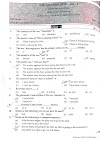Seebeck Effect
The production of e.m.f maintaining a difference of temperature between the junction of two different metals is known as seebeck effect.
Current induced is called thermoelectric current.
Seebeck, arranged a number of metals in a series called seebeck series. Some of the familiar metals in the series are :
Conclusion of Seebeck's Experiment
i. In a thermocouple made of any two metals in the series, the current always flows from a metal coming first in the series to a metal coming later in the series through hot junction.
For e.g. the direction of current in Cu-Fe thermocouple is from Cu to Fe through hot junction.
in Sb-Bi thermocouple, direction of current is Sb to Bi through cold junction.
ii. For a given difference in temperature of two junctions of a thermocouple, the value of thermo-emf developed in a thermocouple increases with the increase in separation between the two metals in seebek series. So, Sb-Bi produces maximum thermo-emf. for a given difference in temperature.
iii. For a given thermocouple, with the increase in temperature of hot junction the thermoemf first increases, becomes maximum for one temperature of hot junction and then decreases with increase in temperature.
The thermo e.m.f becomes zero for one temperature of hot junction called temperature of inversion.
Neutral Temperature ()
It is that temperature of hot junction for which the thermo-emf produced in a thermocouple is maximum.
Neutral temperature depend upon the nature of the material of a thermocouple but is independent of temperature of cold junction.
It is constant for a given thermocouple.
For Cu-Fe thermocouple, the value of neutral temperature is ..
Temperature of Inversion ()
It is that temperature of hot junction for which the thermo-emf becomes zero and beyond this (), emf in a thermocouple reverses its direction.
It depends upon the nature of material of thermocouple and temperature of cold junction.
varies with (temperature of cold junction)
Seebeck coefficient [S]
It is defined as the rate of change of thermo-emf with temperature difference of hot and cold junctions of a thermocouple.
[Emf vs (in hot junction curve is parabolic )]
are constants which depends upon nature of metals forming the thermocouple.
At neutral temperature, E is maximum
P.S In a thermocouple, the thermoelectric power at neutral temperature is zero.
: thermoelectric power is , if temperature of hot junction lies in between temperature of cold junction and neutral temperature and is for temperature between neutral temperature and temperature of inversion.
PELTIER EFFECT
It states that if current is passed through a junction of two different metals, the heat is either evolved or absorbed at that junction.
This effect is the reverse of Seebeck effect.
The effect is reversible.
The quantity of heat evolved or absorbed at a junction dur to Peltier effect is proportional to the quantity of charge crossing that junction.
where Petier's coefficient
Seebeck coefficient
Thomson's Effect
The absorption or evolution of heat energy along the entire length of a conductor, when electric current is passed through a thermocouple [circuit of two wires of different metals] is called Thomson Effect.
Thomson's Effect is a reversible effect.
Thomson;s effect is for Cu, Sb, Ag.
Thomson's effect for Pb is .
Thomson's coefficient
The emf that exists between two points of a uniform conductor which has a temperature difference of (or ) is called Thomson's coefficient().
Potential difference between two points of a metal rod, having temp. diff. .
Thomson's coefficient is also defined as the amount of heat energy evolved or absorbed over and above the Joule's heating effect between the two points of a conductor maintained at a unit temperature difference when unit current is passed for 1 second through the conductor.
P.S Joule's heating effect is irreversible effect while Seebeck effect, Peltier effect and Thomson's effect are reversible process.









0 Comments